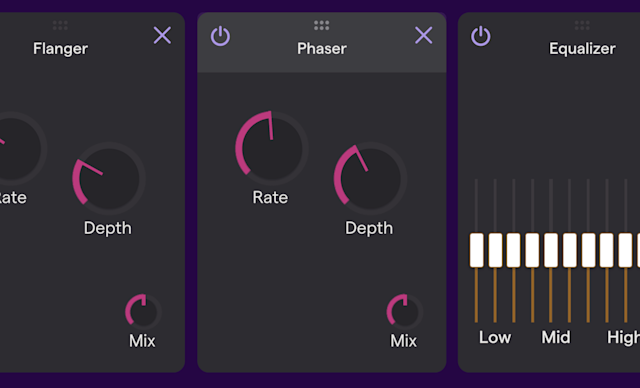The power of phaser: Texture and movement for your productions
October 11, 2024 - Discover how the phaser can elevate your tracks, bringing movement and creativity to your mixes.

If you've ever heard an undulating guitar that seems to float in the air, or a synthesizer that moves in an endless wave, you've probably encountered the phaser. This modulation effect is a favorite and most used among music producers. But what does the phaser really do and how can you use it in your mixes?
In this article, I'll take you through the fascinating world of the phaser: what it is, how it works, where it comes from and, most importantly, how you can take advantage of it to take your productions to the next level.
What is the phaser?
The phaser is a modulation effect that alters the phase of an audio signal, which means it changes the temporal relationship between different frequencies in the sound. This creates constructive and destructive interference, resulting in frequency peaks and valleys, giving rise to a characteristic sweeping or “swooshing” sound. In simple terms, the phaser takes the original sound, copies it, and then delays parts of the signal to create a smooth, oscillating motion.
In a mix, this effect can add a sense of depth and dynamics, making static sounds move and breathe. It's one of those effects that, when used well, can transform a boring sound into something captivating.
A Little History
The phaser originated in the electronic laboratories of the 1960s, where engineers experimented with circuits that manipulated the phase of audio. It quickly became popular in the 1970s, especially in psychedelic and rock music. Artists such as Jimi Hendrix and Pink Floyd's David Gilmour used the phaser on guitars and synthesizers, creating expansive, ethereal soundscapes.
Over time, the phaser has found its way into a wide variety of genres, from classic rock to electronic music, pop and hip hop, showing its versatility and ability to adapt to different styles.
Breaking Down the Phaser Parameter
When you're faced with a phaser, whether it's on an analog pedal or a digital plugin in a DAW like soundtrap, you'll notice a number of controls that, when properly understood, can open up a world of possibilities. Let's go through them.
Rate: Controls the speed of the sweep. A lower rate produces a smooth and spacious effect, while a higher rate creates a faster and often more intrusive sweep.
Depth: Determines how pronounced the sweep is. A low depth will keep the phaser subtle, while a high depth will make it more obvious and wide, affecting more frequencies in the spectrum.
Mix: Controls the amount of effect that is added to the original signal.
Feedback: Adds a portion of the processed signal back to the input, which can intensify the effect. Feedback can make the phaser more resonant, but too high a value can become too shrill.
Stages: Phasers often come in configurations of 2, 4, 6 or even more stages. Each stage adds an additional filter to the signal, making the effect more complex and richer in nuance.
Soundtrap offers its own version of this amazing effect. With a simple and compact design that opens up many possibilities when it comes to experimenting in your productions.

How to Use the Phaser in Your Productions
This is where the phaser really starts to shine: in creative use within your mixes. For a beginning producer, it can be tempting to apply the phaser without much thought, but the key to using it masterfully is to be aware of how it interacts with the other elements of your production.
Guitars and Phasers: The Perfect Marriage
Since Hendrix's time, the phaser has been one of guitars' best friends. A riff with a well-tuned phaser can go from simple to hypnotic. Here's a tip: if you want your guitar to sound spacious and undulating, set the rate low and let the phaser add movement without dulling the original sound. The depth should not be too deep; ideally you should feel the sweep, but without it completely taking over the natural timbre of the guitar.
2. In Vocals: Less is more
While an unusual effect on lead vocals, the phaser can add a layer of interest and dimension to backing vocals. Set the phaser to a low rate and depth to keep the effect subtle, almost like a whisper in the background.
Advanced tip: Try automating the feedback at specific points to make the vocals more dynamic and interact with other effects, such as delay.
3. Synthesizers: Moving energy
Synthesizers and phasing have a very special relationship. If you're working with pads, leads or even basses, the phaser can make those sounds come alive, bringing a sense of fluidity and energy. On atmospheric pads, for example, a 6- or 8-stage phaser can add harmonic complexity and make the sound seem to spin in space.
4. Drums and Percussion Techniques
This is a less explored, but very interesting field. By applying a phaser to percussion elements, especially hi-hats or drums, you can create unexpected rhythmic textures. The phaser here can serve to break up the rigidity of percussion, giving it a more organic and lively feel.
A trick: apply the phaser only on some percussion layers, while leaving others unprocessed. This creates rhythmic contrasts that can add a new dimension to your beat.
Creative Phaser Techniques
Once you've mastered the basics of the phaser, it's time to get into more experimental territory. Here are some creative techniques that will help you explore new sonic frontiers.
Parallel Phasing
One incredibly useful technique is to phaser in parallel. This allows you to preserve the clarity of the original sound while adding movement and depth. Create an effects bus with the phaser and adjust your mix so that only a portion of the processed signal enters the final mix. This trick is ideal for vocals and guitars, as it prevents the phaser from affecting the clarity of the signal too much.
Parameter Automation
Automation is one of the most powerful tools in music production. Automating the rate, depth and feedback parameters of the phaser throughout a track can generate transient and evolving effects. Instead of a static phaser, you can make the effect change over the course of a song, intensifying at key moments or becoming more subtle when needed.
Combine Phaser with Reverb and Delay
One of phaser's best companions is delay or reverb. By phasing the signal before sending it to a delay or reverb, you can create truly immersive soundscapes. The delay, in particular, amplifies the sweep of the phaser, creating a psychedelic, spacey effect that can add unparalleled atmosphere to your productions.
More Tips for Mastering the Phaser
Don't overload the mix: The phaser can be tempting, but its power is in the balance. If you apply it to every instrument, you run the risk of making your mix fuzzy and muddy. Strategically choose the elements that will benefit most from phasing.
Use different phasers in different parts of the mix: Don't be afraid to use several phasers with different settings in the same production. You may want a subtle phaser on vocals, but a more aggressive one on the synth or guitars.
Automate the Phaser for Transitions: Automating phaser parameters, such as rate or feedback, during key moments in the song, such as in drops or transitions, can generate a dramatic change in ambience without needing to drastically change the elements of the track. This trick is particularly useful in electronic and urban genres where drops are an essential part of the structure.
Combine Phaser with Distortion: Phasing after a distortion can bring out specific frequencies, adding more harmonics to your sound. This is particularly effective in dubstep or trap basslines, where distortion is already a fundamental element.
Read more: Mixing Music: The Knowledge You Need to Mix Like The Pros
The Phaser in Modern Production: A Universal Tool
The phaser is one of those tools that has managed to survive the changing waves of music, from psychedelic rock to the more urban and electronic genres of today. Part of its charm lies in its ability to adapt to different sonic contexts, whether to add movement and subtle texture in genres such as Trap or Jersey Drill, or to generate sweeps and deep oscillations in electronic music styles such as House, Techno or Future Bass.
1. Phaser in Trap and Jersey Drill: Flows and Oscillations
In Trap and Jersey Drill, genres dominated by aggressive rhythmic patterns, deep 808 basses and fast-paced percussion, the use of phaser can be surprisingly effective. Applied subtly to hi-hats or snare rolls, it can add a sense of undulating motion, making percussive elements sound less static and more alive. For example, a phaser with a low rate and moderate feedback on a typical trap hi-hat can create a sense of fluidity that blends perfectly with tight kicks and snares.
In genres like Jersey Drill, which have an undeniable energy and a very strong percussive structure, the phaser can be a useful tool to enhance the movement of bass lines and vocal effects.
Here, a high feedback phaser can add an extra layer of interest to the vocal samples, generating a continuous flow that reinforces the syncopated nature of the genre. The key is to use the phaser to make the main elements feel more organic without losing the characteristic aggressiveness of these styles.
2. Phaser in Electronic Music: An Evolutionary Sound Journey
In electronic music, such as house, techno, and trance, the phaser is indispensable for creating immersive soundscapes and textures. This type of music is characterized by repetitive layers of synthesizers and percussion, and the phaser helps keep these layers in constant motion.
In a techno beat, for example, applying a phaser to a main synth with a slow rate and high depth can generate a subtle sweeping effect, which adds dynamics without interfering with the rhythmic patterns.
3. Urban Electronic Music: Phonk, Future Bass and Beyond
Phonk, with its unique blend of distorted bass and dark vocal samples, is another style where the phaser can shine. In a Phonk track, applying the phaser to a bass line can add dimension and texture without sacrificing the strength of the sound.
A mid-feedback phaser applied after the distortion in the effects chain can help keep the bass dynamic and enveloping, while the high frequencies oscillate smoothly, keeping the energy of the track moving.
Future bass, with its bright chords and expansive melodies, is fertile ground for creative use of the phaser. By applying the effect to synth chords, you can give the track a sense of continuous oscillation, adding interest to otherwise very static sounds.
Here, the trick is to adjust the rate and depth of the phaser so that the movement is subtle enough not to overwhelm the melodic elements. The interaction of the phaser with common sidechain compression techniques creates a constantly evolving sonic environment.
Conclusion
The phaser is much more than just a modulator effect. It is a tool that, when used with intention and creativity, can transform the simplest elements of a production into something dynamic, interesting and constantly moving.
Whether in electronic, urban, or even experimental music genres, the phaser opens up a range of possibilities for any producer looking to add more texture and depth to their music. The secret is in the subtlety and how to make the phaser breathe in the mix, without overshadowing the essence of the track.
About the author
Odiseo is a music producer and mixing and mastering engineer with experience ranging from music creation as a session and concert musician, beatmaker, live sound engineer, and recording engineer, to audio production for short films, providing a broad perspective on technical concepts and musical skills to take music to another level.
Get started with Soundtrap today!